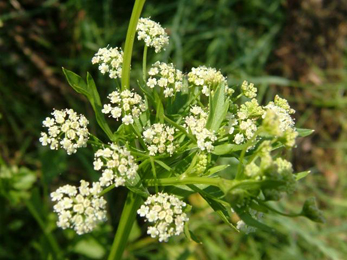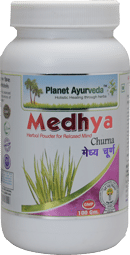Ajmoda, Celery (Apium Graveolens)

Description of plant
Apium graveolens, the botanical name of Ajamoda. This is also known as celery. It is annual or bionomical herbaceous plant. It is known to be the native of Mediterranean regions like Asia, Africa and Europe. It grows up to the height of 60 to 90 cm. the root system is of tap root system. Wild plants grow with fragrance and pinnately divided leaves. In other form, biennial form, plants have a basal rosette of leaves in primary years, later near summers, it florates in off white flowers in umbels. Umbels are with property of inflorescence. The flowers of the plants are so small with five petals of ovule shape with in floured tips. The carpals of the flower are in semi trade sub pentagonal and filiform. The primary ridges of the carpals are very much distinct. The fruit of the plant is schizocarp (a dry fruit when ripe, splits into single seeded parts). These fruits are aromatic, 1 to 2 mm in diameter, with two mericarps, sub orbicular and ellipsoid. The colour of the flowers are greyish brown. There is cross pollination found in this plant. Ajamoda is ancestor of two different kinds of crops.
Apium graveolens, which grow for its crisp edible leaf stalks and leaves.
Another one is ajamoda roots, grow for the edible, turnip like enlarged roots.
What is the Ajamoda
Ajamoda is a very important plant with great ayurvedic medicinal properties. Scientifically ajamoda is known as Apium graveolens. Apium graveolens comes under the family of Apiaceae. The genus is derived from latin, means bee because bees are attracted towards its off white flowers. The species graveolens means heavily perfumed. It is cultivated as a cold crop in India.
It is believed that in ancient Greece, people crown the heads of the athletes with the leaves of ajamonda to honor them. In the 17 th century, it got hybridized to make its bitter taste less prominent.
Ajamoda is known to treat ailments of urinary , digestive, cardiovascular and respiratory. These help to cure high blood pressure, low appetite, digestive weakness, inflammation, bacterial and microbial infections.
This plant contains phytochemicals which have main responsibility to cure and treat diseases. This plant has carbohydrates, alkaloids, glycosides flavonoids steroids. The plant has phenols and furocoumarins, two main active components. The phenols include apigenin, tannins, apiin, isoquercitrin, graveobioside A and B and phytic acid. The furocoumarins contains osthenol, isopimpinellin, celerin, bergapten, isoimperatorin, celereosideand 5 and 8-hydroxy methoxypsoralen, apiumoside, apiumetin and apigravrin. The seeds and leaves oil of the plant refer to have fatty acids, volatile oils and sesquiterpene alcohols.
On the other hand, plant derived components include camphene, cymene, sedanenolide, palmitoleic, palmitic, oleic, myristoleic, stearic acid, limonene, β-pinene, α-thuyene, p-cymene, γ-terpinene, limonene, santalol, β-eudesmol myristicic, myristic, linoleic, terpinolene, α-eudesmol, 3-n-butyl phthalideand phthalide and α-pinene. The tuber of the plant also have phytochemicals like 5-methoxypsoralen, methoxsalen and the allergen profiling.
Its seeds have very great importance as it contains two to three % of essential oil. It is known to contain glycosides, frocoumarin, selinene, limonene and frocoumarin.
Classification
- Kingdom - Plantae
- Subkingdom - Tracheobionta
- Superdivision - Spermatophyta
- Division - Magnoliophyta
- Class - Magnoliopsida
- Subclass - Rosidae
- Order - Apiales
- Family - Apiaceae
- Genus - Apium
- Species - Graveolens
Habitat
This plant belongs to the lowlands of Italy. It is first cultivated as a food in 1623 in France. From the streets of the Italy, its cultivation spreads out in Sweden, Egypt, Ethopia, Algeria and Asia to India. In India, it is grown in Punjab, Haryana, Utter Pradesh and Western Himalayas. Punjab produces around 90% of the ajamoda in India.
Names
- Latin name - Apium graveolens
- Sanskrit name – Ajamoda, Ayamoda, Ajmoja, Dipyaka
- Hindi name – Ajmuda, Ajmod
- Bengali name – Randhuni, Banyamani
- Kannada name – Oma, Ajavana, Omakki
- Malayalam name - Omam
- Tamil name - Omam
- Telugu name – Naranji vamu
- Marathi name – Oova, ajmoda
- Oriya name - Banajuani
- Gujarati name – Bodi ajamo, ajamo
- Kashmiri name – Fakhazur, banjuan
- Punjabi name – Valjawain, ajmod
- Urdu name – Ajmod
- Unani name – Karafs-e-hindi
- Assamese name – Bonjamani, yamani, ajowan
- French name - Celeri
- Hungarian name - Zeller
- Spanish name - Apio
- Swedish - Seller
- Irish - Soilire
- Danish - Seller
- Indonesian - Seledri
Ayurvedic Properties
| Hindi / Sanskrit | English | ||
| Rasa | Katu, Tikta | Taste | Pungent, Bitter |
| Guna | Laghu, Rooksha | Physical Property | Light, Dry |
| Virya | Ushna | Potency | Hot |
| Vipaka | Katu | Metabolic Property (After Digestion) | Pungent |
Ajamoda Effects on doshas
It balances kapha and vata.
Ajamoda Classical categorization
| Charak Samhita | Vagbhata | Sushrut Samhita |
|
Pippalyadi group of herbs |
Pippalyadi group of herbs |
Ancient Verse about Ajamoda

Bhavprakash nighantu edition of 1998: verse 53-54, page no-26-27.
It states the names and properties of the Ajamoda. The names of Ajamoda are Ajamoda, Kharashva, Mayoora, Deepyaka, Brahmkusha, Kharvi and Lochakarkata.
It is bitter in taste and piercing, promotes digestive fire and pacifies kapha and vata. It is hot in potency and increases heat in the body. It is good for heart, aphrodisiac and provides strength. It manages eye diseases, worm infestation, vomiting, hiccups and urinary tract infections.
References
The Bhavprakash nighantu with elaborated Hindi commentary by Padmashri prof. K.C. Chunekar, edited by Dr. G.S. Pandey: edition of 1998; verse 53-54, page no- 26-27.
Practical Uses of ajamoda
This plant has antispasmodic diuretic anthelmintic aphrodisiac, emmenagogue, laxative, sedative toxic carminative and stimulant properties.
It possess anti-inflammatory properties that reduces the swelling and pain of the joints.
It shows Antifungal activity against Shigella dysenteries, Salmonella typhi, Staphylococcus aureus Staphylococcus album, Maintains blood pressure and cholesterol in normal state.
Roots are diuretic in nature, helps in hypertension and urinary disorders.
It is very helpful in case of hysteria as enhances restfulness and sleep.
This plant is used in treating rheumatism and kidney problems.
Celery seeds are famous to treat diseases like bronchitis, asthma, liver, and spleen diseases.
The roots and the ripe seeds are known for galactogogue, diuretic, nervine stimulant and emmenagogue properties.
It promotes menstruation.
These have anti-cancer properties due to anti-cancer chemicals like polyacetylens and phthalide. These can detoxify carcinogens present in cigarette.
It helps to prevent swelling in the body.
Parts used
Ajamoda Seeds, Fruits
Dosage
Two to four grams
Precaution
Avoid extra use in the case of pregnancy. It can cause uterine contractions.
Ayurvedic Product from Ajamoda
Medhya Churna is one of the herbal formulation by Planet Ayurveda in which Ajamoda herb used.
MEDHYA CHURNA
This churna is blend of various herbs. One of the main herb is Ajamoda.
This churna helpful in the condition of Insomnia, loss of memory, anxiety and lack of concentration. It rejuvenates the nervous system.
Parts used are Roots and fruits.




